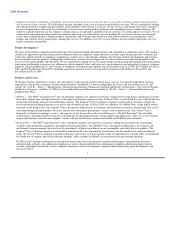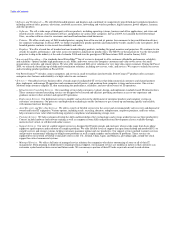Dell 2008 Annual Report Download - page 16
Download and view the complete annual report
Please find page 16 of the 2008 Dell annual report below. You can navigate through the pages in the report by either clicking on the pages listed below, or by using the keyword search tool below to find specific information within the annual report.
Table of Contents
transitions present execution challenges and risks. If we are unable to effectively manage a new product transition, our business and results of
operations could be unfavorably affected.
• Our growth strategy depends on our ability to successfully transform our sales capability and to add to the scope of our product and services
offerings. Our growth strategy involves reaching more customers worldwide through new distribution channels, such as consumer retail,
expanding our relationships with value-added resellers, and augmenting select areas of our business through targeted acquisitions. Our goal
continues to be to optimize the balance of liquidity, profitability, and growth with a focus on moving the weight of the product portfolio to higher
margin products and recurring revenue streams. Our ability to grow sales of these higher margin products, services and solutions depends on our
ability to successfully transition our sales capabilities and add to the breadth of our higher margin offerings through selective acquisitions. If we are
unable to effectively transition our sales capabilities and grow our product and services offerings, our business and results of operations could be
unfavorably affected.
• Disruptions in component or product availability could unfavorably affect our performance. Our manufacturing and supply chain efficiencies give
us the ability to operate with reduced levels of component and finished goods inventories. Our financial success is partly due to our supply chain
management practices, including our ability to achieve rapid inventory turns. Because we maintain minimal levels of component and product
inventories, a disruption in component or product availability could harm our financial performance and our ability to satisfy customer needs.
• Our reliance on vendors for products and components creates risks and uncertainties. We require a high volume of quality products and
components from third party vendors. In addition, we are continuing to expand our use of original design manufacturing partnerships and
manufacturing outsourcing relationships in order to generate cost efficiencies, deliver products faster and better serve our customers in certain
segments and geographical areas. Our increasing reliance on these vendors subjects us to a greater risk of shortages, and reduced control over
delivery schedules of components and products (which can harm efficiencies), as well as a greater risk of increases in product and component costs
(which can harm our profitability). In addition, defective parts and products from these vendors could reduce product reliability and harm our
reputation.
• We could experience manufacturing interruptions, delays, or inefficiencies if we are unable to timely and reliably procure components and
products from single-source or limited-source suppliers. We maintain several single-source or limited-source supplier relationships, either because
multiple sources are not available or the relationship is advantageous due to performance, quality, support, delivery, capacity, or price
considerations. If the supply of a critical single- or limited-source product or component is delayed or curtailed, we may not be able to ship the
related product in desired quantities and in a timely manner. Even where multiple sources of supply are available, qualification of the alternative
suppliers and establishment of reliable supplies could result in delays and a possible loss of sales, which could harm operating results.
• Our business is increasingly dependent on our ability to access the capital markets. We are increasingly dependent on access to debt and capital
sources to provide financing for our customers and to obtain funds in the U.S. for general corporate purposes, including share repurchases, funding
customer receivables, and acquisitions. Additionally, we have customer financing relationships with companies whose business models rely on
accessing the capital markets. The inability of these companies to access such markets could force us to self-fund transactions or forgo customer
financing opportunities, potentially harming our financial performance. The debt and capital markets have been experiencing and may continue to
experience extreme volatility and disruption. These issues, along with significant write-offs in the financial services sector, the re-pricing of credit
risk, and the current weak economic conditions have made, and will likely continue to make, it difficult to obtain funding. The cost of accessing
debt and capital markets has increased as many lenders and institutional investors require higher rates of return. Lenders have also tightened
lending standards, and reduced or ceased their lending to certain borrowers. We believe that we will be able to obtain appropriate financing from
third parties even in light of the current market conditions; nevertheless, changes in our credit ratings, deterioration in our business performance, or
adverse changes in the economy could limit our ability to obtain financing from debt or capital sources or could adversely affect the terms on
which we may be able to obtain capital, which could unfavorably affect our net revenue and profitability. See "Part II — Item 7 — Management's
Discussion and Analysis of Financial Condition and Results of Operations — Liquidity and Capital Commitments — Liquidity."
• We face risks relating to our internal controls. If management is not successful in maintaining a strong internal control environment, material
weaknesses could reoccur, causing investors to lose confidence in our reported financial information. This could lead to a decline in our stock
price, limit our ability to access the capital markets in the future, and require us to incur additional costs to improve our internal control systems
and procedures.
12
























